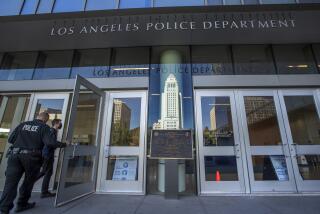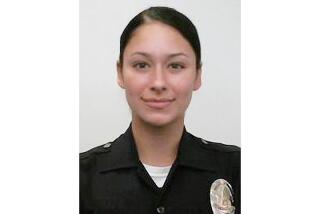Chief Says Officer Who Killed Driver, 13, Acted Within Rules
- Share via
Los Angeles Police Chief William J. Bratton has concluded that the officer who shot 13-year-old Devin Brown last year acted appropriately -- a decision that sets up a potential high-profile conflict with the city’s civilian Police Commission, which plans to debate the matter today.
Bratton found that the shooting was a tragic but proper use of force by an officer who was protecting his life, according to department sources who spoke on condition of anonymity because they were not authorized to discuss the chief’s decision before its release.
But the Los Angeles Police Commission will have the final word on whether the shooting by Officer Steve Garcia complied with department rules.
Commission President John Mack, who was sharply critical of the shooting before he took office, told The Times recently that the Brown shooting was the most important the panel has considered in years. For many longtime critics of the department, how the commission rules will be seen as a defining test of Mayor Antonio Villaraigosa’s professed desire to have a tougher panel that is more independent of the chief than in the past.
Brown was shot and killed early Feb. 6 after leading officers on a brief car chase in South Los Angeles.
Garcia said he fired at Brown’s car after the teenager accelerated in reverse toward the officer, making him fear for his life. A department probe backed Garcia’s account, and prosecutors decided in December not to file charges against him.
The shooting generated widespread protests. Among the critics was Mack, who before his appointment, was the longtime head of the Los Angeles Urban League.
In an opinion piece for The Times shortly before he took over as head of the commission, he wrote that “the reality in this city is that too often police officers stereotype black youths as gang members and too often they cross the line in going after those they see as the ‘bad guy.’
“The LAPD has a long-standing institutional culture in which some police officers feel that they have the tacit approval of their leadership ... to brutalize and even kill African American boys and men.”
When Mack took office, he immediately criticized what he considered the slow pace of the Brown investigation. He also moved the new commission’s first meeting into larger quarters, where dozens of community activists calling for the officer’s firing overflowed the regular meeting room.
“Just because I’m in a new position doesn’t mean I forgot my past,” he told them.
In an interview a few days ago, Mack stressed that the commission -- not the chief -- had the final word on the officer.
“I truly believe the LAPD made significant strides for the better,” Mack said. “But when it comes to incidents such as this, it brings back memories.”
If the commission were to find Garcia’s use of force outside LAPD policy, any effort toward dismissal would mean a hearing before an internal panel.
In March, Bratton ordered changes in police training for shooting into moving vehicles. At the time, Bratton said the instructions, which were designed to further limit such shootings, were developed to train officers “not to put themselves in a situation tactically where they become a victim, in which their only resort is a last resort and that’s to shoot.” The training stresses that officers should “get out of the way,” he said.
In addition to the policy change, Bratton and the LAPD have presented their probe of the Brown case as a model of openness. In the days after the shooting, Bratton allowed his internal affairs chief to give a rare public presentation of the evidence that was carried live on TV stations.
The department also performed an elaborate reconstruction of the scene with the aid of Hollywood technical experts.
Garcia and his partner were on patrol about 3:45 a.m. when they saw a car driven by Brown run a red light. They tried to pull the car over, but a short pursuit ensued. A few minutes into the chase, the car skidded onto a sidewalk at 83rd Street and Western Avenue with the police car 17 feet behind. Garcia got out of his car with his weapon drawn.
At that point, Brown’s car accelerated backward, hitting Garcia’s police cruiser on its right side. Garcia jumped out of the way before firing into the car, according to a statement that a witness, Miles Carthron, made to police. Garcia fired 10 shots, hitting Brown seven times.
The car Brown was driving had been stolen, but Garcia and the other officer were unaware of that at the time.
Bratton, whose report will be presented to the commission today, concluded that Garcia had only seconds to respond and that his actions fell within department guidelines, according to the sources.
Under LAPD policy, officers can use deadly force to protect officers or the public from death or an imminent threat. It remains unclear whether Bratton will sign off on all of Garcia’s tactics. If Bratton finds fault in Garcia’s tactics, he could be required to undergo new training.
The commission today will consider Bratton’s findings, along with a report by the department’s independent inspector general.
In the past, the Police Commission generally has worked in lock-step with the chief -- especially since the popular Bratton took office in 2002.
But when Villaraigosa took office last year, he appointed new commissioners, saying they would be “vigorous in their oversight.” The appointment of Mack won immediate praise from South Los Angeles activists who have long criticized the LAPD’s treatment of blacks.
There have been signs that the commission is willing to break ranks with Bratton in some cases.
In November, the commission -- which also includes two former federal prosecutors, Anthony Pacheco and Andrea Ordin; bank executive and civil rights activist Shelley Freeman; and San Fernando Valley auto-dealer attorney Alan J. Skobin -- overruled Bratton’s recommendation on another shooting.
That case involved a detective with the Special Investigation Section who shot an unarmed burglary suspect in 2004. Bratton had concluded that the officer acted within policy, but the commission disagreed.
“As we’ve shown already, we aren’t afraid to differ with the chief when it’s appropriate to hold an officer accountable,” Mack said. “We will consider the chief’s recommendation and also the inspector general’s view, and we’ll weigh it all. But the final call will be with the Police Commission.”
Mack has been on the front lines of the issue of police use of force for more than 30 years. He was a dissenting voice in several controversial LAPD incidents. Those included the 1979 slaying of Eulia Mae Love, a black woman who, irate over a utility’s threat to shut off her gas because of an unpaid bill, was shot after throwing a kitchen knife at two officers; the 1991 beating of Rodney G. King; and the 1999 fatal shooting of Margaret Laverne Mitchell, a homeless woman who allegedly threatened officers with a screwdriver.
But Mack, unlike some activists, is also public about his belief that the department has improved since the days of former Chief Daryl F. Gates.
“For those who say nothing has changed in 40 years, I say it has,” Mack has said.
Among activists, the decision will set a tone -- though some are skeptical that Mack can make much of a difference.
“I don’t really see them doing anything” to Garcia, said Najee Ali, leader of Project Islamic Hope. “Part of the problem is the LAPD basically was allowed to shoot at cars at the time. That is why after Devin Brown’s killing they changed that policy.”
More to Read
Sign up for Essential California
The most important California stories and recommendations in your inbox every morning.
You may occasionally receive promotional content from the Los Angeles Times.











